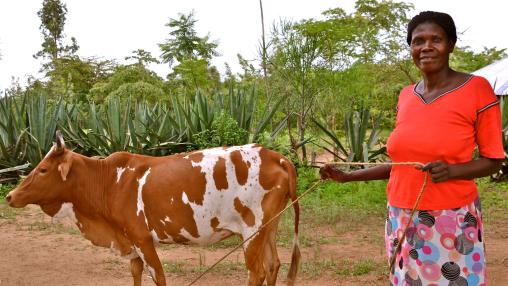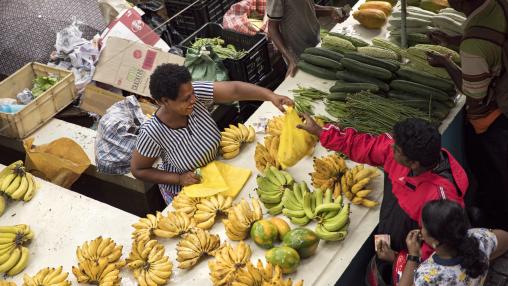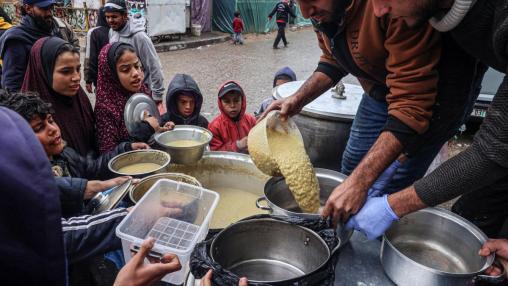Worsening food insecurity, waning response capacity: Options for a better way forward
Food crises arise from the complex interplay of conflict, poverty, climate variability, and economic shocks, resulting in acute food insecurity among vulnerable populations. According to the latest Global Report on Food Crises (2025), the number of people facing severe levels of acute food insecurity has tripled over the past decade, rising from around 100 million in 2016 to nearly 300 million people in 2024.

The future of climate change and food system research: 2025 Global Food Policy Report
The realities of a changing climate are becoming increasingly clear, with temperatures rising around the world and extreme weather events, like flooding and droughts, becoming more and more frequent. April 2025 was the second hottest April globally on record, and evidence suggests such anomalous high temperatures could become the norm rather than the exception.
2025 Global Food Policy Report | Food Policy: Lessons and Priorities for a Changing World
Over the last 50 years, the world’s food systems have evolved tremendously amid major economic, environmental, and social changes. Throughout this period, policy research has played a critical role in providing evidence and analysis to inform decision-making that supports agricultural growth, better livelihoods, and improved food security, nutrition, and well-being for all.
Cost of a Healthy Diet Dashboard
The Cost of a Healthy Diet dashboard offers an interactive platform for analyzing the affordability of nutritious diets globally. Users can explore country and region level data on the indicators of cost of a healthy diet per person per day, presented through dynamic maps and graphs. The dashboard enables comparisons across time and regions and allows users to examine the contribution of specific food groups such as fruits, vegetables, animal source foods, legumes, nuts, seeds, oils, and fats relative to staple foods within a least cost nutritious diet.
Export Restrictions Tracker
The Food and Fertilizer Export Restrictions Tracker is a tool developed to monitor and document export restrictions on food products and fertilizers implemented by countries during global crises, such as the COVID-19 pandemic and the Russia-Ukraine conflict. By gathering data from various sources, including news articles and official government statements, the tracker provides up-to-date information on these trade policies and assesses their potential impacts on global food security.

High global phosphate prices pose potential food security risks
Fertilizer prices experienced a significant surge in 2021, driven by the post-COVID 19 global economic recovery. Russia’s February 2022 invasion of Ukraine propelled prices even higher. Broad economic sanctions on key fertilizer exporters Russia and Belarus exempted agricultural products but triggered further economic disruptions. Overall, the conflict heightened market uncertainties regarding the availability of potash, phosphate, and nitrogen-based fertilizers in international trade.

What do we know about the future of measuring food systems?
Food, land, and water systems face daunting challenges in the future, and the body of research exploring these challenges is growing rapidly. This note is part of a series developed by the CGIAR Foresight Initiative to summarize what we know today about the future of various aspects of food systems. The goal of these notes is to serve as a quick reference, point to further information, and help guide future research and decisions.
Key messages
Learning Support for a Multi-Country Climate Resilience Programme for Food Security
The Learning Support for a Sub-Saharan Africa Multi-Country Climate Resilience Program for Food Security, launched in 2023, aims to enhance food security and climate resilience across 14 African countries. This collaboration among CGIAR, the World Food Programme, and the Norwegian Agency for Development Cooperation (Norad) has three pillars: scaling disaster risk financing, transforming food systems with sustainable school meals and clean cooking, and supporting smallholder farmers.

One year of war in Gaza: Food emergency continues with no end in sight
With conflict in the Middle East now escalating into Lebanon and beyond, Palestinians in the Gaza Strip continue to face dire food security conditions. One year has passed since the October 7, 2023 Hamas attacks on Israeli civilians, triggering the Israeli military retaliation and war that have killed more than 41,000 Palestinians and devastated the livelihoods of Gaza’s population of over 2 million.
Debt Distress and the Right to Food in Africa
More than half of low-income countries are at risk of debt distress or have already defaulted. The debt crisis, while exacerbated by recent crises, has been looming for several years. According to the United Nations, 3.3 billion people now live in countries that spend more on interest repayments than on education or health, and in sub-Saharan Africa, governments are spending 53 percent of revenue on debt servicing.